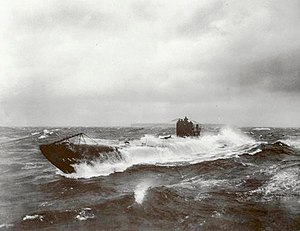SM UB-123
 UB-148 at sea, a U-boat similar to UB-123.
| |
| History | |
|---|---|
| Name | UB-123 |
| Ordered | 6 / 8 February 1917[1] |
| Builder | AG Weser, Bremen |
| Cost | 3,654,000 German Papiermark |
| Yard number | 296 |
| Laid down | 13 July 1917[2] |
| Launched | 2 March 1918[3] |
| Commissioned | 6 April 1918[3] |
| Fate | Sunk 19 October 1918[3] |
| General characteristics [3] | |
| Class and type | Type UB III submarine |
| Displacement | |
| Length | 55.85 m (183 ft 3 in) (o/a) |
| Beam | 5.80 m (19 ft) |
| Draught | 3.72 m (12 ft 2 in) |
| Propulsion |
|
| Speed |
|
| Range |
|
| Test depth | 50 m (160 ft) |
| Complement | 3 officers, 31 men[3] |
| Armament |
|
| Service record | |
| Part of: |
|
| Commanders: |
|
| Operations: | 2 patrols |
| Victories: | |
SM UB-123 was a German Type UB III submarine or U-boat in the German Imperial Navy (German: Kaiserliche Marine) during World War I. She was commissioned into the German Imperial Navy on 6 April 1918 as SM UB-123.[Note 1]
She torpedoed and sunk Leinster, a vessel operated by the City of Dublin Steam Packet Company on 10 October 1918, shortly after the new parliamentary based German Government under Max von Baden had asked U.S. President Woodrow Wilson to negotiate an armistice.
Leinster went down just outside Dublin Bay. Over 500 people perished in the sinking – the greatest single loss of life in the Irish Sea.
UB-123 struck a mine at the North Sea Mine Barrage on 19 October 1918, all 36 crew members died in the event.[3]
Construction
[edit]She was built by AG Weser of Bremen and following just under a year of construction, launched at Bremen on 2 March 1918. UB-123 was commissioned later the same year under the command of Oblt.z.S. Robert Ramm. Like all Type UB III submarines, UB-123 carried 10 torpedoes and was armed with a 10.5 cm (4.13 in) deck gun. UB-123 would carry a crew of up to 3 officer and 31 men and had a cruising range of 7,280 nautical miles (13,480 km; 8,380 mi). UB-123 had a displacement of 512 t (504 long tons) while surfaced and 643 t (633 long tons) when submerged. Her engines enabled her to travel at 13.9 knots (25.7 km/h; 16.0 mph) when surfaced and 7.6 knots (14.1 km/h; 8.7 mph) when submerged.
Summary of raiding history
[edit]| Date | Name | Nationality | Tonnage[Note 2] | Fate[5] |
|---|---|---|---|---|
| 16 July 1918 | Anine | 1,299 | Captured as prize | |
| 16 July 1918 | Constantin | 831 | Captured as prize | |
| 16 July 1918 | Hjortholm | 1,400 | Captured as prize | |
| 10 October 1918 | Leinster | 2,646 | Sunk | |
| 16 October 1918 | Caloria | 4,095 | Damaged |
References
[edit]Notes
[edit]- ^ "SM" stands for "Seiner Majestät" (English: His Majesty's) and combined with the U for Unterseeboot would be translated as His Majesty's Submarine.
- ^ Tonnages are in gross register tons
Citations
[edit]- ^ Rössler 1979, p. 55.
- ^ Helgason, Guðmundur. "WWI U-boats: UB 123". German and Austrian U-boats of World War I - Kaiserliche Marine - Uboat.net. Retrieved 13 February 2009.
- ^ a b c d e f Gröner, Jung & Maass 1991, pp. 25–30.
- ^ Helgason, Guðmundur. "WWI U-boat commanders: Robert Ramm". German and Austrian U-boats of World War I - Kaiserliche Marine - Uboat.net. Retrieved 10 March 2015.
- ^ Helgason, Guðmundur. "Ships hit by UB 123". German and Austrian U-boats of World War I - Kaiserliche Marine - Uboat.net. Retrieved 10 March 2015.
Bibliography
[edit]- Bendert, Harald (2000). Die UB-Boote der Kaiserlichen Marine, 1914–1918. Einsätze, Erfolge, Schicksal (in German). Hamburg: Verlag E.S. Mittler & Sohn GmbH. ISBN 3-8132-0713-7.
- Gröner, Erich; Jung, Dieter; Maass, Martin (1991). German Warships 1815–1945, U-boats and Mine Warfare Vessels. Vol. 2. Translated by Thomas, Keith; Magowan, Rachel. London: Conway Maritime Press. ISBN 0-85177-593-4.
- Rössler, Eberhard (1979). Die deutschen U-Boote und ihre Werften: eine Bilddokumentation über den deutschen U-Bootbau; in zwei Bänden (in German). Vol. I. Munich: Bernard & Graefe. ISBN 3-7637-5213-7.
